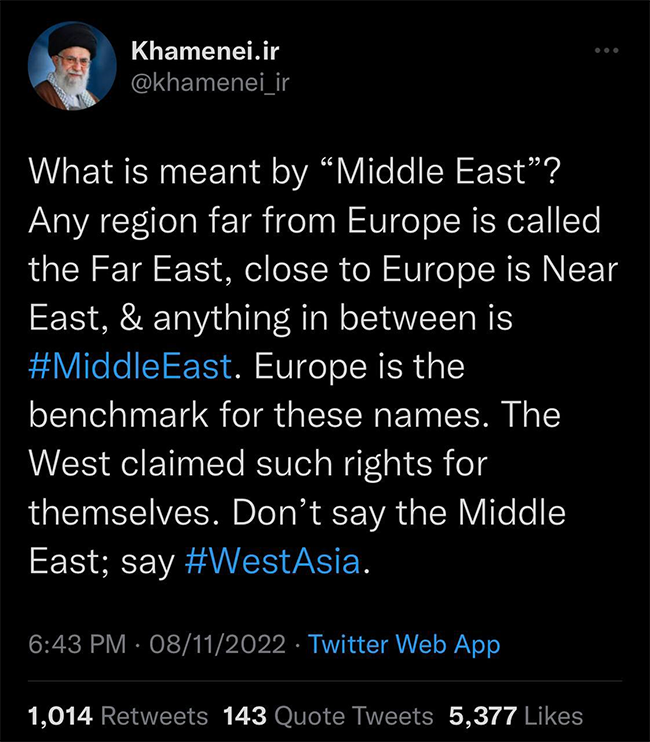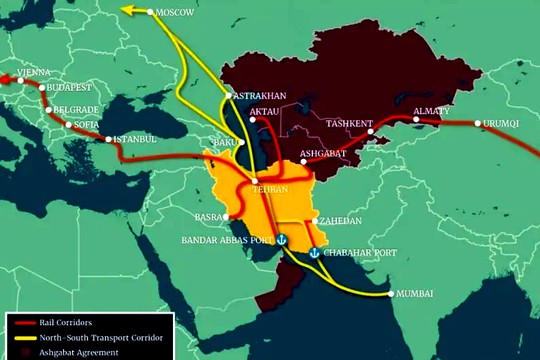Russia and Iran recently held high-level meetings to strengthen their 20-year cooperation treaty. Both countries aim to reduce reliance on the U.S. dollar in international trade, especially with key partners like China. A proposed "Land Bridge" through the Middle East would enable Russia and Iran to expand their influence and transport routes, writes ‘Oil Price’.
A flurry of high-level meetings between very senior Russia and Iranian figures occurred over a four-week period from the end of September to the middle of October. These included Russian Prime Minister Mikhail Mishustin, and Secretary of the Russian Federation Security Council Sergei Shoigu, a senior energy source who works closely with Iran’s Petroleum Ministry exclusively told OilPrice.com last week. President Vladimir Putin himself met with Iran’s new President Masoud Pezeshkian on 11 October in Turkmenistan, and again at the BRICS (Brazil, Russia, India, China and South Africa) summit that ran from 22-24 October.
The focus of these meetings was to ratify key elements of the 20-year deal – ‘The Treaty on the Basis of Mutual Relations and Principles of Cooperation between Iran and Russia’ – approved by Iran’s Supreme Leader Ali Khamenei on 18 January, following the death of Iran’s previous president, Ebrahim Raisi. In several key respects, this Treaty develops key policies of enhanced cooperation laid down in the ‘Iran-China 25-Year Comprehensive Cooperation Agreement’, as first revealed anywhere in the world in my 3 September 2019 article on the subject and analysed in full in my latest book on the new global oil market order. All these deals are aimed at further broadening and deepening the already close cooperation between Iran and Russia, and Iran and China, on energy, trade, finance and banking, and defence matters, among others.
As part of this, several new agreements have been made to closer coordinate the two gas giants’ efforts on exploration, development, production, and marketing of the energy source as delivered through regional pipelines and in LNG form. Russia will continue to split the first right of refusal on all Iran’s key gas (and oil) sites with China according to each country’s broader strategic interests in the region in which each site is located. But there are three bigger imperatives in play in the gas work to be done between Iran and Russia.
One of these was highlighted by the newly-appointed Deputy Oil Minister and Head of National Iranian Gas Company (NIGC), Saeed Tavakoli, who said that a successful example of the sort of collaboration Iran and Russia are envisioning is the Gas Exporting Countries Forum (GECF). Long-touted as a potential ‘Gas OPEC’, the GECF officially moved on 23 December 2008 from being a loose alliance of several leading gas-producing countries into a formal organisation headquartered in Doha, Qatar. Aside from the core members of Russia, Iran, and Qatar, the GECF’s 11 other members comprise Algeria, Bolivia, Egypt, Equatorial Guinea, Libya, Nigeria, Trinidad and Tobago, and Venezuela.
Together, Russia, Iran, and Qatar account for just under 60 percent of the world’s gas reserves, with Russia occupying the number one spot globally – with around 1,688 trillion cubic feet (tcf) of gas – and Iran the number two position (with about 1,200 tcf). Overall, the GECF controls about 71 percent of global gas supplies, 44 percent of its marketed production, 53 percent of its gas pipelines, and 57 percent of its liquefied natural gas (LNG) exports.
The intention of the enhanced cooperation between Russia and Iran in this field is to expedite a series of US$40 billion-worth of gas exploration, development, production, and marketing deals signed between Gazprom and the NIGC. These deals built upon a broad 2022 memorandum of understanding (MoU) between Russia and Iran aimed at controlling as much of the two key elements in the global supply matrix – gas supplied over land via pipelines and gas supplied via ships in LNG form.
According to a statement from Hamid Hosseini, chairman of Iran’s Oil, Gas and Petrochemical Products Exporters’ Union, in Tehran, just after the 2022 MoU with Gazprom had been signed: “Now the Russians have come to the conclusion that the consumption of gas in the world will increase and the tendency towards consumption of LNG has increased and they alone are not able to meet the world’s demand, so there is no room left for gas competition between Russia and Iran.”
Another of the larger imperatives at play in this enhanced cooperation between Russia and Iran will be the continued shift towards using their local currencies in dealings between each other and relevant cooperation partners around the world, and also with their joint biggest energy customer and superpower sponsor, China. This was a particular matter of interest of Russian Prime Minister Mishustin during a meeting with Iranian First Vice President Mohammadreza Aref, with the former highlighting that during his visit 13 cooperation documents relating to strengthening and developing financial and banking cooperation – including expanded use of local currencies – were ratified both each side.
Russia and Iran are acutely aware that a key lever in the U.S.’s global power in general, and over each of them – and their major backer, China – derives from the primary use of the U.S. dollar in international trade, including in the energy markets. This view of the U.S. dollar as a weapon was reiterated by the former executive vice-president of the Bank of China, Zhang Yanling, in a speech in April 2022, saying that the latest sanctions against Russia would “cause the U.S. to lose its credibility and undermine the [U.S.] dollar’s hegemony in the long run.” She further suggested that China should help the world “get rid of the dollar hegemony sooner rather than later.”
For the same reasons, the replacement of the U.S. dollar as the favoured medium of exchange has long been a focus of the Shanghai Cooperation Organisation (SCO), dominated by China and Russia but with a membership comprising several countries of the same view about the U.S. dollar. The move away from the U.S. currency could gain traction in the SCO if pushed sufficiently, as it is the world’s biggest regional political, economic and defence organisation both in terms of geographic scope and population. It covers 60 percent of the Eurasian continent (by far the biggest single landmass on Earth), 40 percent of the world’s population, and more than 20 percent of global GDP.
Aside from its vast scale and scope, the SCO believes in the idea and practice of the ‘multi-polar world’, which China anticipates will be dominated by it by 2030. Veteran Russian Foreign Minister, Sergey Lavrov, has since stated that: “The Shanghai Cooperation Organisation is working to establish a rational and just world order and […] it provides us with a unique opportunity to take part in the process of forming a fundamentally new model of geopolitical integration.”
A final one of the broad imperatives at play in this enhanced cooperation between Russia and Iran are the enormous geopolitically strategic advantages available in building out routes across vast areas of land across the Middle East and beyond through which to transport gas (and oil).
At the most recent series of high-level meetings, all the senior Russian figures wanted assurances from their new Iranian counterparts under new President Pezeshkian that these key routes agreed in the 20-year deal in January would still go ahead. They were assured that they would, according to the Iran source. With broader links into the Russia-Iran International North-South Transport Corridor aimed at developing a network of links across Eurasia, the Russia-Iran Energy Corridor will provide a direct link from Russia to Iran for gas in the first instance.
That said, it is also intended as the first part of the ‘Land Bridge’ that Iran has desperately being trying to create since its 1979 Revolution brought it into being as a global Islamic power. The Land Bridge would run from Iran across Iraq and on to the Mediterranean Sea coast of Russian-controlled Syria. This would enable Iran and Russia to exponentially increase weapons delivery into southern Lebanon and the Golan Heights area of Syria to be used in attacks on Israel as part of a wider rolling plan to further destabilise the Middle East.
With Russia having an extensive military presence along the coast, both with the naval base at Tartus and with the Hmeimim Air Base and nearby listening station at Latakia, the various oil and gas exploration and development contracts shared by Russian, Chinese and Iranian companies operating in Iraq provide the link from Iran to Syria, as analysed in my latest book on the new global oil market order.
Under international law, oil and gas firms are entitled to station as many ‘security personnel’ as they wish in and around these high-value sites, including around the transport system that connects them. Additional support for these hubs along much of the Land Bridge route is likely to come from plans agreed between Iraq and China to construct the US$17 billion Strategic Development Road that will create its own transport corridor from Basra to southern Turkey (close to the Syrian border), and link in with China’s ‘Belt and Road Initiative’.

read more in our Telegram-channel https://t.me/The_International_Affairs

 11:36 05.11.2024 •
11:36 05.11.2024 •























